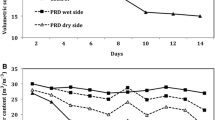Abstract
Main conclusion
First observation that chemical spray can induce limited-transpiration rate under high vapor pressure deficit. It appears that acibenzolar may be key in inducing this water conservation trait.
Irrigation and water use have become major issues in management of turfgrasses. Plant health products that have been introduced into the turfgrass market have been observed to improve plant performance in water stress conditions. In this study, we evaluated whether a selection of common plant health products alter the ability of creeping bentgrass (Agrostis stolonifera L.) to control transpiration under high vapor pressure deficit (VPD). The plant health treatments—Daconil Action®, Insignia®, and Signature®—were applied to plots on golf course putting greens located in Raleigh NC and in Scottsdale, AZ. Using intact cores removed from the putting greens, transpiration rates were measured over a range of VPDs in controlled conditions. In all cases stretching over a 3-year period, bentgrass cores from field plots treated with Daconil-Action limited transpiration under high VPD conditions, while check treatments with water, and others treated with Insignia® or Signature® did not. Transpiration control became engaged when VPDs reached values ranging from 1.39 to 2.50 kPa, and was not strongly influenced by the field temperature at which the bentgrass was growing. Because all plots in NC had been treated with chlorothalonil—the key ingredient in Daconil Action to control diseases—it was concluded that the likely chemical ingredient in Daconil Action triggering the transpiration control response was acibenzolar. This is the first evidence that the limited-transpiration trait can be induced by a chemical application, and it implies significant potential for ameliorating drought vulnerability in cool-season turfgrasses, and likely other plant species.

Similar content being viewed by others
References
Beard JB, Kenna MP (2008) Water quality and quantity issues for turfgrasses in urban landscapes. Ames, CAST, p 298
Carter TE, Rufty TW (1993) A soybean plant introduction exhibiting drought and aluminum tolerance. In: Kuo EG (ed) Adaptation of vegetables and other food crops to temperature and water stress. Asian Vegetable Research and Development Center Publ, Tainan, pp 335–346
Cathey SE, Kruse JK, Sinclair TR, Dukes MD (2011) Tolerance of three warm-season turfgrasses to increasing and prolonged soil water deficit. HortScience 46:1550–1555
Fletcher AL, Sinclair TR, Allen LH Jr (2007) Transpiration responses to vapor pressure deficit in well watered “slow-wilting” and commercial soybean. Environ Exp Bot 61:145–151
GCSAA (2009) Golf Course Environmental Profile, vol II. Water use and conservation practices on U.S. Golf Courses. Environmental Institute for Golf. http://www.eifg.org
Gholipoor M, Choudhary S, Sinclair TR, Messina CD, Cooper M (2013) Transpiration response of maize hybrids to atmospheric vapour pressure deficit. J Agron Crop Sci 199:155–160
Huang B, Xiaozhong L (2009) Physiological responses of creeping bentgrass to heat stress affected by phosphonate fungicide applications. Int Turfgrass Soc Res J 11:799–806
Kramer PJ (1983) Water relations of plants. Academic Press, New York, p 489
McCarty LB, Gann JR, Wells CE, Bruce TF, Gerard PD (2013) Physiological responses of creeping bentgrass to pigment-containing products. Agron J 105:1797–1802
Sadok W, Sinclair TR (2009) Genetic variability of transpiration response to vapor pressure deficit among soybean (Glycine max [L.] Merr.) genotypes selected from a recombinant inbred line population. Field Crops Res 113:156–160
Sermons SM, Seversike TM, Sinclair TR, Fiscus EL, Rufty TW (2012) Temperature influences the ability of tall fescue to control transpiration in response to atmospheric vapour deficit. Funct Plant Biol 39:979–986
Seversike TM, Sermons SM, Sinclair TR, Carter TE, Rufty TW (2013) Temperature interactions with transpiration response to vapor pressure deficit among cultivated and wild soybean genotypes. Physiol Plant 148:62–73
Shekoofa A, Balota M, Sinclair TR (2014) Limited-transpiration trait evaluated in growth chamber and field for sorghum genotypes. Environ Exp Bot 99:175–179
Yang Z, Sinclair TR, Zhu M, Messina CD, Cooper M (2012) Temperature effect on transpiration response of maize plants to vapour pressure deficit. Environ Exp Bot 78:157–162
Author information
Authors and Affiliations
Corresponding author
Rights and permissions
About this article
Cite this article
Shekoofa, A., Rosas-Anderson, P., Carley, D.S. et al. Limited transpiration under high vapor pressure deficits of creeping bentgrass by application of Daconil-Action® . Planta 243, 421–427 (2016). https://doi.org/10.1007/s00425-015-2417-y
Received:
Accepted:
Published:
Issue Date:
DOI: https://doi.org/10.1007/s00425-015-2417-y




